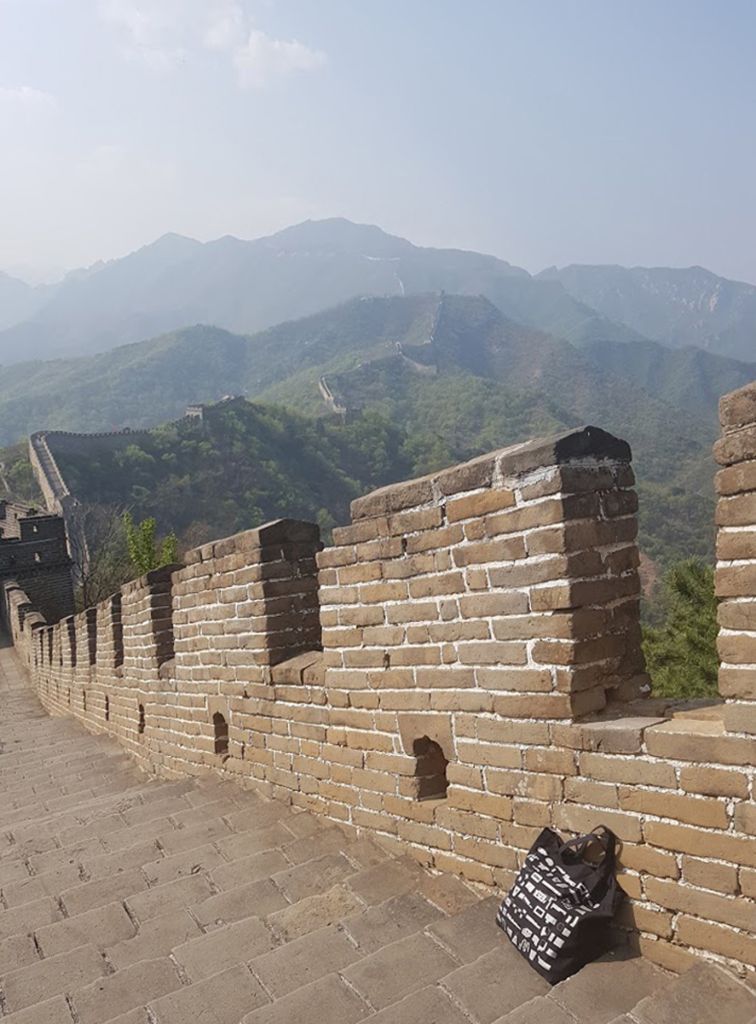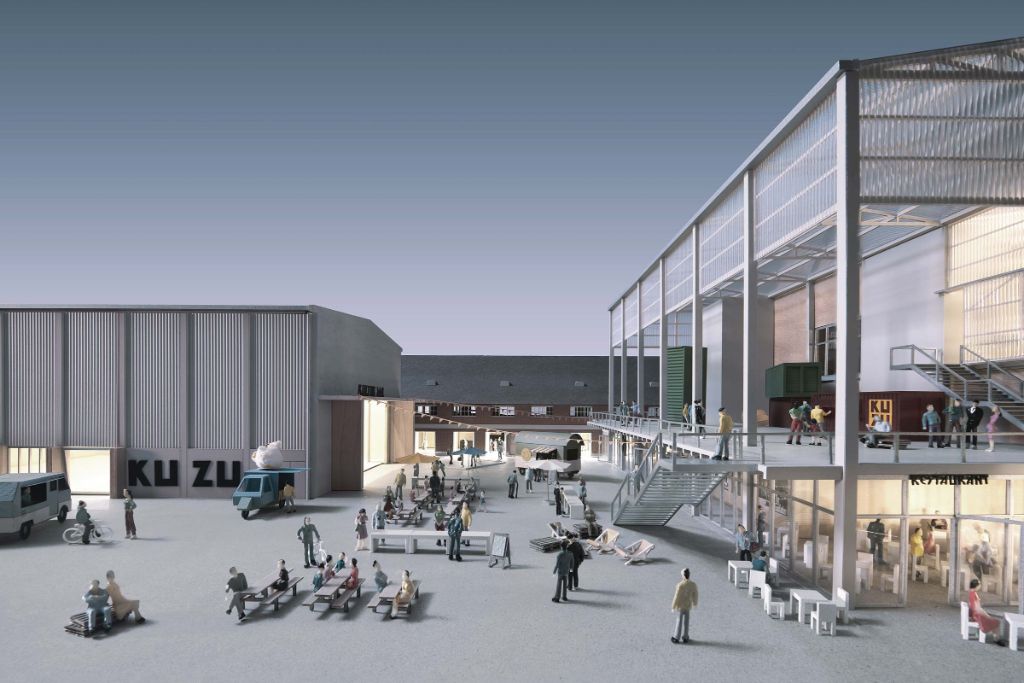KANAL – Centre Pompidou
Our proposal for the transformation of the former Citroën Yser car factory into a 40,000 m² art and cultural centre in Brussels was won through an international competition launched in 2017 by the Brussels Urban Development Corporation. The well-known landmark building, a 21-metre-high glass palace at Square Sainctelette, will be one of the largest cultural venues in Europe when it is completed in 2024, home to all forms of cultural creativity: the visual arts and architecture, but also dance, drama, film, literature and music. KANAL, as the venue will be known, will provide opportunities for learning as well as a framework for diverse curatorial opportunities, a network of buildings and public spaces that act as an open forum, a catalyst for debate and social interaction.
The existing building is a fine example of elegant industrial engineering and the proposal retains as much as possible of the existing structure, returning it to its original grandeur. The ambition of the project is to embrace the industrial identity of the former factory, transforming it with a light touch and a deliberate economy of means. As well as minimising waste, pollution and reducing demolition and construction costs, this conservation strategy embraces the identity of the historical building and transforms the car factory into an urban culture factory, a place of creativity and making. Retaining traces of its past will give the venue a productive, social and informal feel rather than the all-too-often rarefied atmosphere of many international art venues. More than a container of art and a stage for performance, Kanal aims to be a public forum that can be appropriated by local residents: a welcoming place inviting visitors to wander, rest, meet or simply be.
A number of key ideas define the physical character of the project:
The iconic former showroom, a 21-metre-high glass palace and symbol of Citroën, already a prominent landmark in the city, now becomes the front door and shopfront of the new KANAL. A place of exchange between the city and the museum – A new Stage for Brussels – the Showroom will be restored to become the grand urban interior that it once was to now accommodate installations, performances or concerts as well as a restaurant and Les Amis du Kanal.
The horizontal fascia running around the existing building, signifying its identity and charisma, is extended to enfold the museum with an information-rich and curatable interactive ribbon. This horizontality is further emphasised in the interior with the reconnection of showroom and workshop to create an extensive and accessible public landscape. By regaining and reinforcing the horizontal silhouette of the Yser Garage and its spatial continuity inside, the showroom and the garages themselves become the landmark for the new KANAL. The existing cross axis of wide circulation through the garages, like a ‘cardo and decumanus’ define an underlying figure of 12,000 m² public space around which the building is organised both at ground and first floor levels, connected by the vast existing ramps. The longitudinal Nave and interconnecting Museum Street, with entrances at each of their ends, connect all the activities of the museum and reach out to the city beyond.
Three new volumes, like vast houses, are inserted within the expansive space of the garage floors providing environmentally controlled spaces from which the activities of the museum emanate. As the existing structure cannot meet the structural or acoustic performance criteria required the gallery rooms in the new volumes enable and create possibilities for a broad curatorial policy. One accommodates the CIVA Architecture Museum and archive, the other the Museum of Contemporary Art and the third, shared uses such as auditorium and office spaces. The exhibition spaces of the Musuem are spread over four levels with a large galley space per floor, each of different ceiling heights and figured ceilings, allowing many configurations and connections. A basement gallery of 6.5 metre is also provided with separate access available directly from the outside. The galleries at Levels 0 and 1 allow direct connections to adjoining workshop spaces. Gallery rooms at Levels 2 and 3 are self-contained and can benefit from direct or indirect natural light with views of the city and canal.
The building is understood as a place of production as much as a place of display. Multipurpose workshop spaces and ateliers are spread around the building providing space for learning and making for visitors, artists and local people. Through production a strong interaction with the neighbourhood is achieved, reaching out and drawing in. The vast public interior, with multiple entrances, will have an exciting simultaneity – a special acoustic with many things happening in the distance. There are places of quiet and others of major gathering. The views between things and the naming of spaces and rooms reinforce the museum as a single organism and connect the visitors to a unique collective experience and the curatorial governance will ensure a spirit of the ‘unfinished’. As such KANAL is a national and cultural test-site, embedded in the city’s memory and future, a centrepiece to the Plan Canal with its emphasis on urban industry.
Visualisations: © Secchi Smith, London
Photographs construction site: © Atelier Kanal, Brussels
Aerial photographs: © Wobbe Buyse, Brussels
Model photographs: © EM2N, Zurich
Film: © CIVA Foundation, Brussels
Index: 257 BRX
Dates: Competition 2017–2018 (stage 1 and 2) · Planning phase: 2018–2019 · Expected construction phase: 2020–2024
Team Atelier Kanal / EM2N
Project team (competition): Francesco Apostoli, Stephen Bates, Baptiste Blot, Béatrice Bruneaux, Jasper Caenepeel, Serafina Eipert, Damiano Finetti, An Fonteyn, Kirsten Gabriëls Webb, Fabian Hörmann, Sunayana Jain, Estelle Jakubowski, Mathias Müller, Daniel Niggli, Evelien Pletinckx, Marije van Diemen, Konrad Scheffer, Elke Schoonen, Jonathan Teuns, Mark Tuff, Jitse van den Berg, Philippe Viérin, Andrea Zandalasini · Project team (planning / construction): Francesco Apostoli, Dennis Baganz, Stephen Bates, Kristoffel Boghaert, Job Borgonjon, Jasper Caenepeel, Zacharie Cabaud, Arnaud De Francesco, Arabella El Ginawy, Emmanuelle Farine, An Fonteyne, Nicole Fröhlich, Ludovic Gaffarel, Nils Köpfer, Louis Lories, Francesca Martellono, Mathias Müller, Daniel Niggli, Cristina Pérez Guillén, Sebastian Pfammatter, Ellen Piot, Kerstin Rienecker, Andrea Sassi, Edmund Savory, Miguel Steel Lebre, Daniel Trimmel, Mark Tuff, Jitse van den Berg, Konstantijn Verbrugge, Philippe Viérin
Model making: Jennifer Bottlang, Jonas Rindlisbacher
Specialist planners (competition)
Civil engineer / building services: Buro Happold Ltd, London / Bureau d’études greisch sa, Liège · Building physics: Egeon Ingenieurs, Melle / Bureau d’études greisch sa, Liège · Acoustics: Kahle Acoustics srl, Brussels · Fassade planning: Gevelinzicht ingenieur-architecten, Antwerp · Fire protection: FESG, Gent / Bureau d’études greisch sa, Liège · Planning heating / ventilation / air-conditioning / cooling technology and sanitary services: Buro Happold Ltd, London / Bureau d’études greisch sa, Liège · Electrical services planning: Buro Happold Ltd, London / Bureau d’études greisch sa, Liège · Cost management: eld architects bv, Antwerp · Health and safety: Buro Happold Ltd, London / Bureau d’études greisch sa, Liège · Lighting design engineer: Buro Happold Ltd, London / Bureau d’études greisch sa, Liège · Media architecture: iart ag, Basel · Art: Benoît van Innis, Brussels
Specialist planners (execution)
Building physics: Egeon Ingeniers, Melle / Bureau d’études greisch sa, Liège · Acoustics: Kahle Acoustics srl, Brussels · Planning heating / ventilation / air-conditioning / cooling technology and sanitary services: Bureau d’études greisch sa, Liège · Electrical services planning: Bureau d’études greisch sa, Liège · Fire protection: FESG, Gent / Bureau d’études greisch sa, Liège · Cost management: eld architects bv, Antwerp · Fassade planning: Gevelinzicht ingenieur-architecten, Antwerp · Health and safety: Arvico, Herent · Lighting design engineer: Bureau d’études greisch sa, Liège · Media architecture: iart ag, Basel · Signage: Cartlidge Levene, London · Art: Benoît van Innis, Brussels and Sarah Smolders, Brussels
Location
Brussels, Belgium
Procedure
Competition, 1st prize, together with noAarchitecten, Brussels and Sergison Bates architects, London
Client
Gouvernement de la Région de Bruxelles-Capitale City of Brussels represented by Fondation KANAL
Year
2017–2024
Status
Ongoing
Program
Archives, Art exhibition halls, Ateliers, Auditorium, Bookshop, Building services, Café, Changing rooms, Cinema, Delivery Area, Depots, Event spaces, Exhibition spaces, Information counter, Kitchen, Library, Museum shop, Offices, Parking, Production spaces, Reception, Restaurant, Roof terrace, Seminar rooms, Storage spaces, Teaching spaces, Ticket booth, Visitor areas, Workshop spaces
Size
40,000 m²
Museum of Modern and Contemporary Art 12,000 m², CIVA Foundation (archive and museum) 7,000 m², Public use 12,000 m², Shared use 9,000 m²
Costs
CHF 125 m.


















































































































